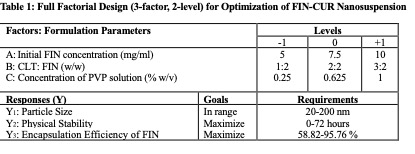Formulation and Delivery - Chemical
Category: Poster Abstract
(M1230-11-75) Rational Development of Fingolimod-Curcumin Nanosuspension as a Potential Intranasal Neuroprotective Therapy after Ischemic Stroke
Monday, October 23, 2023
12:30 PM - 1:30 PM ET

Xinyue Zhang, MS (she/her/hers)
PhD STUDENT
University of Hong Kong
Hong Kong, United Kingdom
Xinyue Zhang, MS (she/her/hers)
PhD STUDENT
University of Hong Kong
Hong Kong, United Kingdom- SC
Shing Fung S.F. Chow, Ph.D. (he/him/his)
University of Hong Kong
HONG KONG, Hong Kong
Presenting Author(s)
Main Author(s)
Co-Author(s)
Purpose: Ischemic stroke is a fatal disease worldwide. Current treatments include tissue plasminogen activator and endovascular thrombectomy, but they are often limited by short treatment windows and complex procedures before treatment. This leaves an unmet medical need, and it is thus urgent to develop a new neuroprotective therapy for ischemic stroke [1]. Both fingolimod (FIN) and curcumin (CUR) have individually demonstrated neuroprotective effects after ischemic stroke [2-4]. Formulating FIN and CUR in nanoparticles for intranasal delivery could synergistically improve the therapeutic efficacy. With the aid of Quality-by-Design (QbD), this study aimed at producing size-tunable and stable FIN-CUR co-loaded nanosuspensions enabling optimal intranasal therapy for management of ischemic stroke.
Methods: The FIN-CUR nanosuspensions were prepared with polyvinylpyrrolidone (PVP) and cholesterol (CLT) as stabilizers by flash nanoprecipitation (FNP) using a four-stream multi-inlet vortex mixer. The initial concentration of CUR was fixed at 2.5 mg/ml. The particle size and polydispersity of the FIN-CUR nanosuspensions were measured by dynamic light scattering while the physical stability of the nanosuspension was monitored by a < 20% change in size and visual examination of any precipitants during storage. The drug loading (DL) and encapsulation efficiency (EE) of FIN or CUR were calculated after the centrifugal ultrafiltration and HPLC assay. To examine the main effects and interaction of various formulation parameters on the physical stability, particle size and EE (FIN) of the nanosuspension, a 2-level, 3-factor full factorial design was employed (Table 1). Design-Expert 13 was used to construct the regression models by ANOVA and the optimal formulation parameters were identified by the desirability function approach. Then nanosuspensions were co-spray freeze dried with mannitol as cryoprotectant to produce FIN-CUR co-loaded dry powder, and the cytotoxicity of the resulting powder in RPMI 2650 cells was evaluated using the MTT cell viability assay compared with the raw FIN.
Results: The physicochemical properties of FIN-CUR nanoparticles were measured under different formulation parameters based on the Table 1. The regression models were statistically significant for all responses, with good agreement between experimental and predicted values (R2 ≈ 0.98 for particle size, R2 ≈ 0.97 for physical stability and R2 ≈ 0.99 for EE of FIN). As shown in Figure 1, all factors and their interactions were significantly associated with the particle size and EE (p < 0.0001) while only factors A, B and interaction terms AB, AC, and ABC were significantly associated with the stability (p < 0.0001). Higher concentrations of FIN and PVP as well as CLT: FIN ratio could produce larger particles while increased concentration of CLT or decreased concentration of FIN could generate FIN-CUR nanosuspension with greater stability. Higher concentrations of PVP could produce nanosuspension with lower EE of FIN while higher concentrations of CLT or FIN gave opposite trends. Based on the regression models, the optimized nanosuspension formulation with the highest desirability (Desirability =0.946) value was set as A=5 mg/ml, B=3:2 (w/w) and C=0.25% (w/v) respectively, as the Contour Plots shown in Figure 2. Experimental with the optimized parameters produced FIN-CUR nanosuspensions (n=3) with a particle size of 134 ± 0.6 nm, PDI of 0.179 ± 0.021, physical stability of 72 ± 0 hours, and EE (FIN) of 90.67 ± 0.08% & EE (CUR) of > 99.99%. The DLs of FIN (5.33 ± 0.25%) and CUR (3.40 ±0.10 %) were consistent to the theoretical values. The results from the MTT study suggested that both FIN-CUR dry powder and raw FIN were not cytotoxic within a clinically relevant concentration range of 5 nM -1 µM [5].
Conclusion: FIN-CUR nanosuspension was successfully produced and optimized with the aid of QbD. The optimized nanosuspension was further converted into a nanoagglomarated dry powder formulation by spray freeze drying for nose-to-brain delivery, with negligible cytotoxicity in RPMI 2650 cells within the tested concentrations. Further optimization of the dry powder formulation and more characteristics of dry powder will be tried and measured as the next step. Our study could pave the way for developing a new and superior treatment option to patients with ischemic stroke.
References: 1. Mallah, K., et al., Anti-inflammatory and Neuroprotective Agents in Clinical Trials for CNS Disease and Injury: Where Do We Go From Here? Front Immunol, 2020. 11: p. 2021.
2. Hasegawa, Y., et al., Activation of sphingosine 1-phosphate receptor-1 by FTY720 is neuroprotective after ischemic stroke in rats. Stroke, 2010. 41(2): p. 368-74.
3. Ran, Y., et al., Curcumin Ameliorates White Matter Injury after Ischemic Stroke by Inhibiting Microglia/Macrophage Pyroptosis through NF-κB Suppression and NLRP3 Inflammasome Inhibition. Oxid Med Cell Longev, 2021. 2021: p. 1552127.
4. Fu, Y., et al., Impact of an immune modulator fingolimod on acute ischemic stroke. Proc Natl Acad Sci U S A, 2014. 111(51): p. 18315-20.
5. Candadai, A.A., et al., Neuroprotective Effects of Fingolimod in a Cellular Model of Optic Neuritis. Cells, 2021. 10(11).
Acknowledgements:This work is financially supported by an internal research grant at the University of Hong Kong (P/N:104006626).
 Table 1: Full Factorial Design (3-factor, 2-level) for Optimization of FIN-CUR Nanosuspension
Table 1: Full Factorial Design (3-factor, 2-level) for Optimization of FIN-CUR Nanosuspension Figure 1: Pareto charts of effects of initial concentration of FIN (A), CLT:FIN ratio (B), concentration of PVP solution (C) and their interactions on particle size (Figure 1 (a)), physical stability (Figure 1 (b)) and EE of FIN (Figure 1 (c)). The factors above the black lines have statistically significant effects on the responses (p < 0.05). Normal probability plots indicate the direction, significance, and magnitude of effects and their interactions on particle size (Figure 1 (b)), physical stability (Figure 1 (d)), and EE of FIN (Figure 1 (f)). Factors with blue or orange bars show negative or positive effects on the responses.
Figure 1: Pareto charts of effects of initial concentration of FIN (A), CLT:FIN ratio (B), concentration of PVP solution (C) and their interactions on particle size (Figure 1 (a)), physical stability (Figure 1 (b)) and EE of FIN (Figure 1 (c)). The factors above the black lines have statistically significant effects on the responses (p < 0.05). Normal probability plots indicate the direction, significance, and magnitude of effects and their interactions on particle size (Figure 1 (b)), physical stability (Figure 1 (d)), and EE of FIN (Figure 1 (f)). Factors with blue or orange bars show negative or positive effects on the responses. Figure 2: 2D Contour Plots for particle size (Figure 2 (a)), physical stability (Figure 2 (b)), and EE of FIN (Figure 2 (c)) as the initial concentration of FIN (x-axis) and CLT:FIN ratio (y-axis) at a fixed concentration of PVP solution (0.25% w/v). The white boxes show the predicted response values with the highest desirability of the optimized formulation.
Figure 2: 2D Contour Plots for particle size (Figure 2 (a)), physical stability (Figure 2 (b)), and EE of FIN (Figure 2 (c)) as the initial concentration of FIN (x-axis) and CLT:FIN ratio (y-axis) at a fixed concentration of PVP solution (0.25% w/v). The white boxes show the predicted response values with the highest desirability of the optimized formulation.